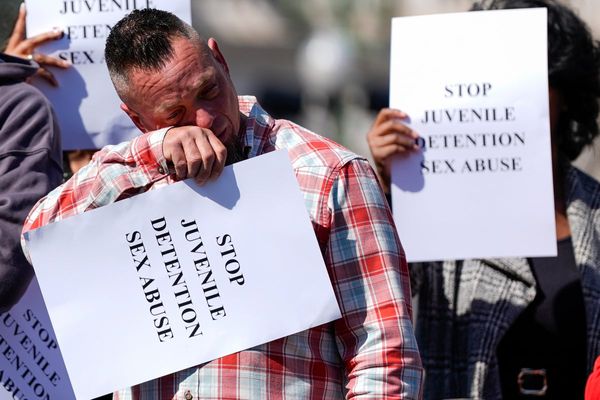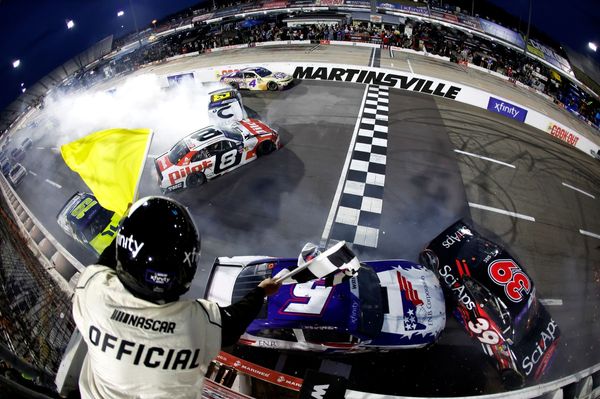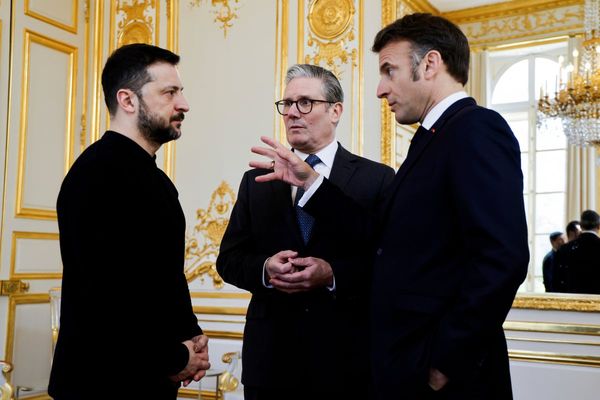
Russia’s deployment of tens of thousands of troops along the country’s border with Ukraine has led to the biggest standoff between Moscow and the West in years. The Kremlin has been seeking a formal guarantee that NATO will never admit Ukraine and other former Soviet states as members and roll back troop deployments to the status quo in 1997, before the alliance admitted Eastern and Central European states.
Moscow’s demands have been met in turn by Western threats of sanctions and military support if Russia invades its smaller neighbor, raising the prospect of an armed conflict over Ukraine’s future. President Biden said Friday he believed Russian President Vladimir Putin had made the decision to invade Ukraine and that he expects an attack that would target the Ukrainian capital, Kyiv. U.S. officials say a Russian attack on Ukraine could involve a broad combination of fighter jets, tanks, ballistic missiles and cyber attacks, with the ultimate intention of rendering the country’s leadership powerless.
Attempts to defuse the crisis diplomatically continue. World leaders have embarked on a flurry of international visits to try to resolve the standoff.
Secretary of State Antony Blinkenproposed a last-ditch diplomatic meeting with his Russian counterpart next week that could lead to a potential summit of key leaders.
Mr. Biden previously warned Mr. Putin of “swift and severe costs" if Russia moves against Ukraine and told the Ukrainian leader that the U.S. and its allies would respond rapidly to any further Russian aggression against his country.
U.S. officials say they now expect a Russian attack on Ukraine in the next few days that could involve a broad combination of fighter jets, tanks, ballistic missiles and cyber attacks, with the ultimate intention of rendering the country’s leadership powerless.
Attempts to defuse the crisis diplomatically continue. World leaders have embarked on a flurry of international visits in recent days to try to resolve the standoff.
Secretary of State Antony Blinken proposed a last-ditch diplomatic meeting with his Russian counterpart next week that could lead to a potential summit of key leaders.
Mr. Biden previously warned Mr. Putin of “swift and severe costs" if Russia moves against Ukraine and told the Ukrainian leader that the U.S. and its allies would respond rapidly to any further Russian aggression against his country.
As tensions grew, the U.S. closed its embassy in Kyiv and relocated operations 340 miles west to Lviv near the Polish border. It ordered the destruction of networking equipment and computer workstations and the dismantling of the embassy telephone system, according to U.S. officials familiar with the matter and internal communications reviewed by The Wall Street Journal.
Pro-Russian separatists and Ukrainian authorities have accused each other of breaking a cease-fire along the front line separating the sides in the area. The leader of a Russian-controlled region in Donbas urged civilians to evacuate to Russia as shelling intensified along the front line, with Kyiv saying its troops have been issued orders to exercise restraint in responding to artillery fire so as to not give Moscow a pretext to invade.
Speaking in Munich on Friday, Mr. Blinken said he was deeply concerned that Russia was no longer on the path to a diplomatic solution. “Everything we are seeing, including what you described in the last 24-48 hours, is part of a scenario that is already in play of creating false provocations, of then having to respond to those provocations and then ultimately committing new aggression against Ukraine," Mr. Blinken said.
Why is Ukraine important to Russia?
Ukraine was part of the Soviet Union before it collapsed at the end of the Cold War in 1991, and it borders Russia to its east. The disintegration of the Soviet Union left Russia with a vastly depleted population, territory and economy. It also diminished Russia’s superpower status. Now Mr. Putin is seeking to reclaim some of that glory and undo some of what Russia lost in the Cold War. He has described Russians and Ukrainians as “one people, a single whole."
Does Russia want to invade Ukraine?
Russia has repeatedly denied having plans to invade. But Moscow has massed some 190,000 troops near the Ukrainian border, the biggest military mobilization in Europe since World War II, U.S. officials say, and has been moving tanks, infantry fighting vehicles, rocket launchers and other military equipment westward from bases in Russia’s far east.
In addition, Russia is moving troops and S-400 surface-to-air missile systems into Belarus, which borders Ukraine and NATO members Poland, Latvia and Lithuania. It began military exercises there on Thursday, worrying Western officials who believe it could open a new front on which to attack Ukraine. The Kremlin says the exercises are being held in response to the threat the West poses to Russian security. Russia also has moved several ships near Ukraine’s shores in the Black Sea and the Sea of Azov.
It is also holding naval exercises in the Atlantic and Pacific oceans, and in the Arabian Sea with Chinese naval forces. On Jan. 25, Moscow announced new military exercises in the North Caucasus.
In late January, Western defense officials said Russia had sent medical units to the front, moving to a level of readiness that it hadn’t reached in past buildups.
In massing troops near Ukraine, Mr. Putin’s goal is to extract concessions from Ukrainian President Volodymyr Zelensky and force him to give Russia a say in Ukraine’s future. That would send a message to other former Soviet states that the West can’t guarantee their security. To ratchet up the pressure, Mr. Putin has an array of military options short of a full occupation, from low-profile incursions to a limited conflict in the eastern Donbas region, where Russian-backed separatists have declared themselves independent of Ukraine but aren’t recognized by the government in Kyiv.
On Thursday, representatives of two breakaway Russian-backed and Russian-armed statelets in Ukraine’s eastern Donbas region, known as the Luhansk People’s Republic and the Donetsk People’s Republic, said Ukraine’s armed forces had launched grenades and mortars into their territory.
The Ukrainian government said Kyiv-controlled areas of the Luhansk region came under sustained shelling Thursday morning. A direct hit to a kindergarten in the town of Stanytsia Luhanska injured two teachers, the military said. Shelling also destroyed a house in the village of Vrubivka and hit the courtyard of a high school. There was no immediate information on casualties there, according to the local civilian-military administration.
Such exchanges have occurred regularly in the years since the conflict in Donbas began in 2014, despite a cease-fire agreed to a year later, and have occasionally erupted into wider-scale fighting. But they carry a heightened risk now amid the wider standoff between Russia and the West over Ukraine.
U.S. officials said on Feb. 3 that intelligence showed a Russian plan to stage a fabricated attack by Ukrainian military or intelligence personnel against Russian sovereign territory, or against Russian-speaking people, to justify an incursion into Ukraine. The plan would include Moscow’s use of a propaganda video that would depict “graphic scenes" according to administration officials, of a staged, false explosion with corpses, actors depicting mourners and images of destroyed buildings and military equipment. The U.S. and British governments have repeatedly stated they have secret intelligence warning that Russia is preparing to invade Ukraine. The aim of such statements, Western officials say, is to prevent any such attack from taking place and put the Kremlin off-balance.
On Friday, the White House said it believes Russia could invade Ukraine at any time and urged Americans to leave the country as soon as possible. Only security personnel are left at the U.S. Embassy in Kyiv. A core staff of diplomatic and consular officials have set up operations in the city of Lviv, which is considered safer because it lies farther west near the Polish border.
Where is Ukraine?
Ukraine is located in Eastern Europe and its eastern flank borders Russia. To the west, it is bordered by Poland, Slovakia, Hungary, Romania and Moldova, and to the north by Belarus. The Black Sea runs along Ukraine’s southern coast.
Is Ukraine a U.S. ally and is it part of NATO?
Since the breakup of the Soviet Union when Ukraine gained its independence, the U.S. has had diplomatic relations with the country. The U.S. is eager to see Ukraine thrive as a democracy in the face of what the State Department describes as “continued Russian aggression."
Ukraine isn’t a part of the North Atlantic Treaty Organization but it is a “partner country“ to the military alliance, and agreements in place mean it could become a NATO member in the future. Mr. Biden has said that Ukraine’s prospective membership of NATO isn’t likely in the near term, though he said the decision ultimately belongs to the alliance.
What is NATO doing in response to Russia’s military buildup?
NATO allies are bolstering the alliance’s eastern flank, which borders Ukraine, deploying jet fighters and ships to the region in response. The European Union has set out plans for loans and grants to Ukraine worth more than $1.3 billion. The Pentagon ordered thousands of troops to prepare for possible deployment.
The U.S. and NATO allies have established an air bridge ferrying military aid to Ukraine in an attempt to shore Kyiv up against a possible Russian invasion.
What does Putin want?
Mr. Putin has been clear about wishing to reassert Russia’s influence over its neighbors, particularly Ukraine. In 2014, he annexed Ukraine’s Crimean peninsula, fomenting an eight-year war in the country’s east.
But he has cultivated an aura of unpredictability about his next moves.
So far, Mr. Putin has left Western leaders guessing about whether he would stage a major invasion of Ukraine and provoke a possible breakdown in ties with the West, or whether he would be satisfied with wringing a few concessions from an expansive list of demands he has put forth. These include that NATO guarantees that it won’t give membership to Ukraine.
Moscow has also demanded that NATO curb military exercises in Ukraine and other former Soviet nations, and that the alliance pull its forces back from its eastern member states. NATO deployed about 5,000 troops to Poland and the Baltic countries after Russia invaded Ukraine in 2014.
In his first public remarks on the crisis since December, Mr. Putin on Feb. 1 repeated complaints about NATO’s presence in Poland, Romania and the Baltics, and said Moscow has significant worries about Ukraine joining the U.S.-led alliance.
The Russian leader said the U.S. and its European allies had “basically ignored“ Moscow’s demands for security assurances but expressed a willingness to continue talks.
Mr. Putin met Chinese leader Xi Jinping at a summit in Beijing ahead of the Olympics, where they presented a united front against the U.S., opposing America’s global network of alliances and seeking to nudge it aside as the sole superpower.
On Feb. 7, French President Emmanuel Macron met with Mr. Putin for more than five hours of talks inside the Kremlin. Mr. Macron said the Russian leader had given him assurances that he was open to exploring ways to defuse the Ukraine crisis.
What has the U.S. said to those demands?
The U.S. and its allies rejected Moscow’s demands at a series of meetings with Russian officials in mid-January, arguing that states are free to associate with any other states they choose.
The U.S. delivered unpublished proposals to the Russian Foreign Ministry on Jan. 26 that, according to U.S. officials, included constraints on military maneuvers that Moscow considers provocative. But the Russian leader said his “fundamental concerns"—a drawdown of NATO troops and a bar on Ukraine joining the alliance—had been ignored.
What would happen if Russia invaded Ukraine?
Mr. Biden said that if all of the troops on the border moved into Ukraine, it would amount to the largest invasion since World War II. Russia has amassed sufficient combat power to take cities and substantial swaths of territory in Ukraine, according to the Pentagon.
Should Russia continue adding to its forces and then mount an all-out attack to try to take over the entire country, 25,000 to 50,000 civilians would be killed or wounded, U.S. intelligence assessments project. The extent of the toll would depend on how much fighting there would be in urban areas.
Between 3,000 and 10,000 Russian troops and between 5,000 and 25,000 Ukrainian troops would be killed or wounded, according to the assessments, which added that one million to five million Ukrainians would be displaced.
In the event of an invasion of Ukraine, the U.S. has said it would unleash a barrage of fresh economic sanctions against Russia, hitting major banks, state companies and key imports, though the targets have yet to be confirmed. Mr. Biden has also said the U.S. and NATO would consider further beefing up their presence in Eastern Europe.
Experts say that despite efforts by Moscow to sanction-proof its economy since penalties were imposed after it annexed Crimea, harder-hitting measures could cause the country broad economic pain.
What is the feeling in Ukraine about the crisis?
Ukrainian leaders, excluded from U.S.-Russia talks over the standoff, have urged their citizens not to panic and say the Kremlin’s likely aim isn’t to invade but to destabilize their country in more insidious ways.
Mr. Zelensky, a Russian-speaking ex-comedian who had no political experience when he was elected president of Ukraine, wants his country to join the EU and NATO. He came to power in 2019 promising to end the continuing war with Russia-backed separatists in the east of Ukraine that has so far claimed 14,000 lives.
Many Ukrainians, having endured eight years of that conflict, are resigned and prepared for war with Russia.
Ukraine is bulking up its territorial-defense force, aiming to have a brigade of reservists in each of the country’s regions, able to react quickly if Russia blasts or sneaks its way through.
And in the largest city in eastern Ukraine, sentiment has shifted dramatically against the Kremlin. Any Russian military operation in Kharkiv is now likely to face significant resistance from ordinary civilians.
What is Nord Stream 2 and what part does it play in the crisis?
Nord Stream 2 is a natural-gas pipeline that runs from Russia to Germany, a NATO member, and is awaiting signoff from German regulators.
U.S. lawmakers and some officials worry that the 764-mile pipeline will strengthen Russia’s grip on the European energy market and weaken Ukraine as it tries to resist Russian aggression. Germany is the world’s biggest buyer of Russian gas, drawing more than half of its supply from Russia. Nord Stream 2 would double capacity for Russian gas exports to the country currently being channeled through the parallel Nord Stream 1 pipeline.
President Biden on Feb. 7 said the Russian-built pipeline would be suspended if Russia invades Ukraine, with German Chancellor Olaf Scholz offering support but without explicitly saying the project would be halted. “If Russia invades, that means tanks and troops crossing the border of Ukraine, again, then there will be no longer a Nord Stream 2. We will put an end to it," Mr. Biden said at a joint appearance with Mr. Scholz after the leaders met at the White House.
(Sabrina Siddiqui, William Mauldin and Nancy A. Youssef contributed to this article)







